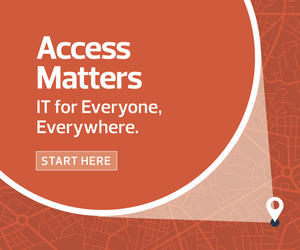EDTECH: Can you offer examples of how IT can help shift the culture?
PAPPAS: IT is uniquely positioned in an organization because we’re everywhere. No matter what function you serve in an organization, IT is a resource to everyone equally. Because of that, we have this unique position to model the importance of diversity and inclusion. It’s present in everything that we do, the way we present ourselves and the way we speak.
If we can really embrace and exemplify the importance of diversity, we can actually have an impact just by how we behave or what we’re doing. What is it that we do when we form a committee, post a job or roll out a service, and are we doing it with diversity and inclusion in mind? Have we gone through the process in a way that takes into account people’s needs and abilities? Have we considered the accessibility aspects of it?
MORE ON EDTECH: Read about how mobile devices are extending students’ access and engagement.
EDTECH: What new ways of doing business has your institution introduced that have incorporated diverse feedback?
PAPPAS: At Rutgers, we have faculty, staff and students from every corner of the earth. So, while we always have areas in which we can do more when it comes to diversity and inclusion, we have some really great things established already. We are looking at recruitment and diversity at every level. When we form groups and task forces, we intentionally make sure that we have different views at the table. We’re making sure that different stakeholders are represented. We’re making sure that we have racial diversity and intellectual diversity at the table.
Diversity is a mindset represented in the systematic structures that we create and in how we approach things. For example, we’ve got a small but dedicated and passionate team that is examining all of our digital assets — websites, online content and other electronic communications — and providing training and talking to people at every level of the organization to help create digital assets with accessibility in mind.
EDTECH: You’ve also been focusing on effective recruitment and retention strategies. Is your IT department doing anything to help Rutgers with recruitment?
PAPPAS: Yes, but there’s a bigger way to think about it. Historically, higher ed has been sort of slow-moving. That’s not to say there aren’t more nimble and agile institutions out there. Now, with COVID-19, that just isn’t going to work when engaging with people remotely. Even if you open up services or classes, some students or faculty might be too high-risk to show up in person. Others might be quarantined or back in their home states or countries. Recruitment is a threefold challenge, with faculty, students and staff. How do we approach it?
For students, we have to focus on their needs. We have to care about the student experience. They need to be able to get the services they rely on, and it has to be a good experience for them. It shouldn’t be stressful. It shouldn’t add to the emotional turbulence of what’s going on right now. It’s about how we triage the kinds of requests we get, so that the right teams are quickly getting to respond to the right questions in the right way.
For faculty, we’re asking them to engage in complete paradigm shifts in a small amount of time. How can we smooth that transition for them? How can we be thoughtful about making the correct services available to support remote or online teaching? Are we choosing good technologies? Are we providing the appropriate amount of training? Do we have mechanisms in place to give quick support where it’s needed? I truly believe that if we take time to assess situations for our staff, there is a way to tweak things and adjust things to help them succeed based on their personal circumstances.













